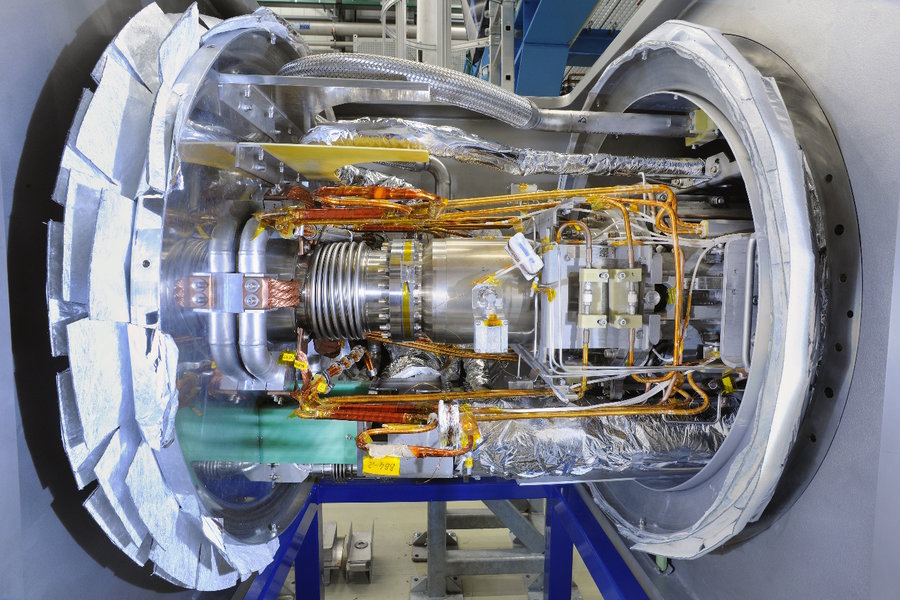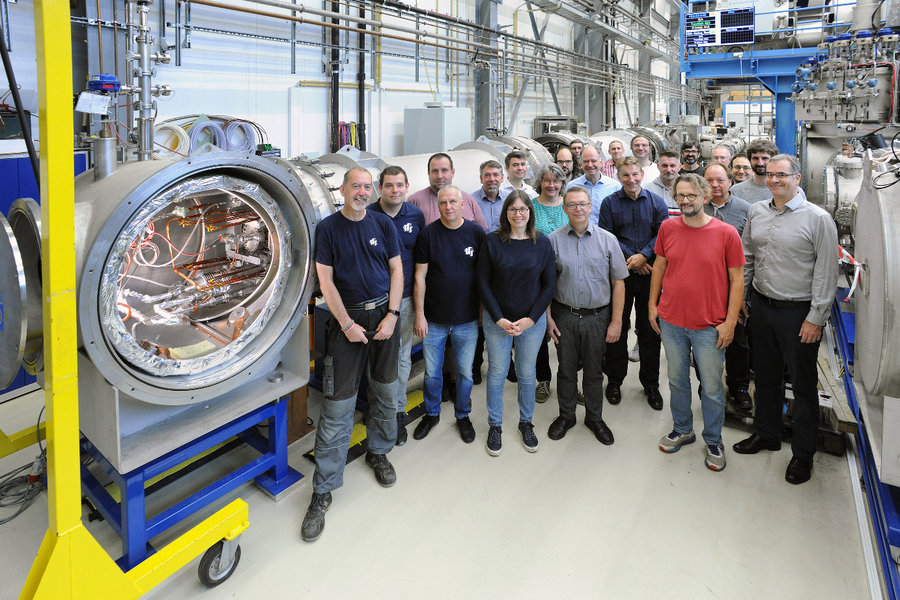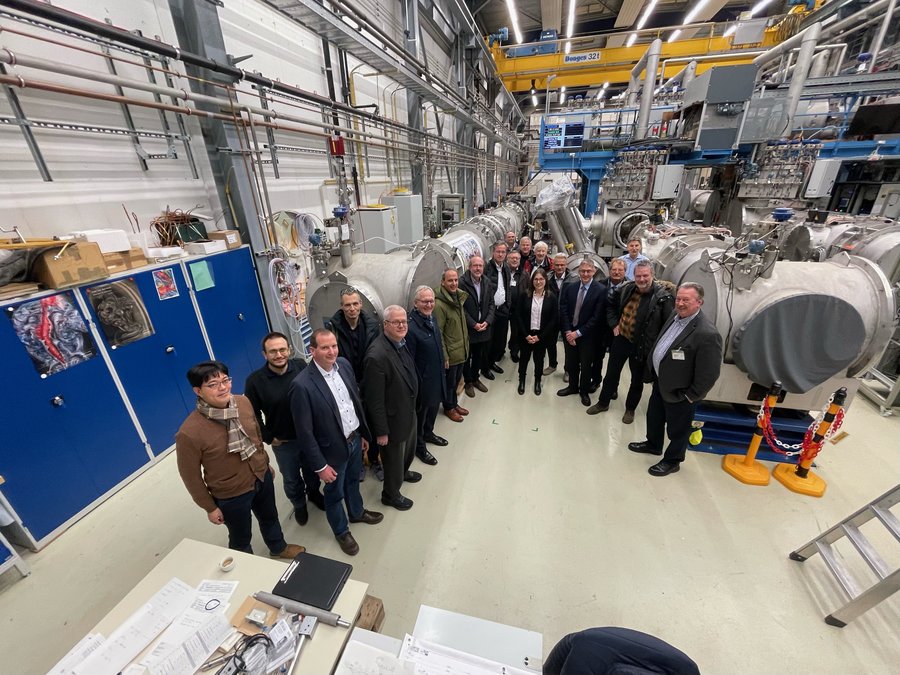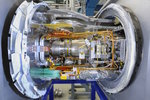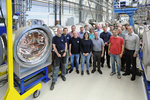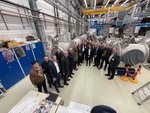Complex performance test at low temperature: test setup of a SIS100 section delivers successful results
19.02.2024 |
Recently, groundbreaking progress has been made for the large FAIR ring accelerator SIS 100: A section of the cryogenic part of the SIS100 was built at the STF series test facility on the GSI/FAIR campus and then tested for the first time at the required operating temperature of -269 degrees Celsius. This decisive step, the so-called string test, marks an important final milestone in the construction of large superconducting circular accelerators. It is mainly used to test the interfaces and the smooth interaction of various components, especially in the interconnection area of the cold masses. The string test is the most important milestone for design verification and performance before the actual installation begins.
The setup now realized at the STF corresponds to a continuous section of the SIS100 arc, consisting of two dipole modules and a one quadrupole module. Other important and technically sophisticated cryogenic components of the local cryogenics, such as the bypass lines and the end boxes that terminate each arc, are also part of the setup.
Cryogenics plays a crucial role in the FAIR project. Superconducting magnets are used in the SIS100 ring accelerator to guide the extremely fast particles and at the same time create an extremely low residual gas pressure (vacuum) in the beam tube. Superconductivity can only be achieved with the aid of highly developed cryogenic technology. It must maintain the required ultra-low temperature along the magnet chains in the entire ring system of the SIS100, which is needed for operation.
All modules include technologically highly advanced, cutting-edge components. In particular, the electrical current used to generate the beam-guiding magnetic fields is conducted in special superconducting cables. To cool these cables and the so-called cold magnetic masses, liquid helium is transported via a hydraulic system and distributed in parallel cooling circuits. Only near the operating temperature of -269 degrees Celsius the electrical resistance in the cables collapses and superconductivity is established. Therefore, a key question to be investigated in the string test is whether the cooling in the parallel circuits is sufficient to maintain superconductivity in every operating state. Similar balancing is required in the parallel cooling circuits as in a conventional heating system. The hydraulic resistance must be set so that a sufficient mass flow is guaranteed in each of the parallel cooling circuits without the pressure in the overall system decreasing too much.
Each individual unit was tested extensively by the manufacturers and approved by the SIS100/SIS18 sub-project at GSI/FAIR. Only the interconnection areas of the large superconducting modules established with the assembly of the string test could not be tested in advance. These interconnection areas are exposed to high forces and stresses. Particularly at the required test pressure of 28 bar, high lateral forces are exerted on the process lines, which must be absorbed by suitable supporting structures. The length contraction of the cold masses of the single modules also has an effect in the connecting areas and must be adequately taken into account in the design in order to prevent damage to the components.
During the assembly of the string test, the various work steps were carried out and documented for the first time. The processes that will also be crucial for installation in the SIS100 tunnel include, for example, welding the process lines, closing the cryogenic vacuum system and soldering the superconducting cables. Each of these work steps was documented on the basis of the string test setup in the form of work instructions, test plans and test protocols for the subsequent tunnel assembly. The assembly was carried out in collaboration with engineers experienced in accelerator assembly from the Institute of Nuclear Physics at the Polish Academy of Sciences (IFJ PAN) in Krakow.
The string test setup has led to numerous important findings with regard to the assembly capability of the units and their design. The findings are used for final design optimization. Even in the first thermal cycle (test run with regular temperature changes, heating and cooling), it was possible to supply all magnets with power as intended in the SIS100 in the future. Even when operating at full power (maximum ramp rate and electrical current), stable operation of the superconducting magnets was observed without quenching (sudden, undesired transition of a superconductor to the normal conducting state).
Other key design requirements and cooling concepts were also demonstrated for the first time in a larger vacuum area. The chamber walls of the ultra-high vacuum system, cooled to -263 °C, functioned as planned as a "super pump" and were able to generate a pressure of <10-12 mbar by freezing out the residual gas particles.
The string will be analyzed in detail over the next few months in many thermal cycles. The so-called cross-talk between the individual circuits of the main magnets also plays an important role. The interaction of the circuits via their electromagnetic fields must be sufficiently small so that the precise course of the currents in the acceleration process is not disturbed. Even with the planned rapid current changes (ramp rate of up to 29,000 amperes/second) and electrical currents of up to 13,000 amperes, the precision of the currents must not deviate from the target value by more than 0.01 per cent at any time.
The available results suggest that the SIS100 can be set up as planned. The expert committee MAC (Machine Advisory Committee), responsible for advising on the technical design and operation of the FAIR facility, has classified the completion of the string test as an important step forward in the project. (BP)




